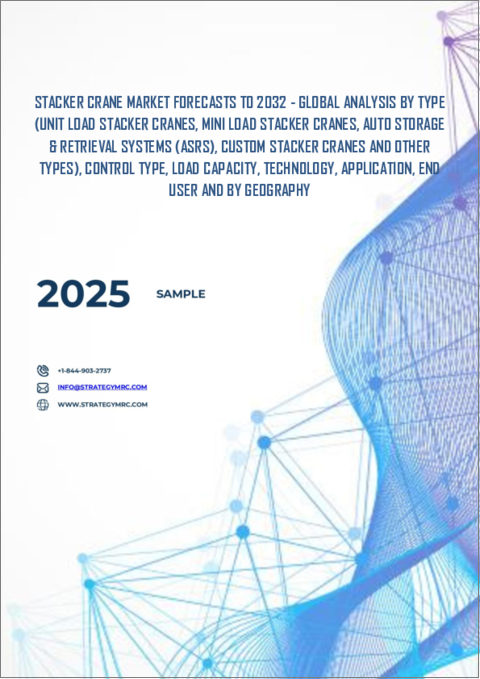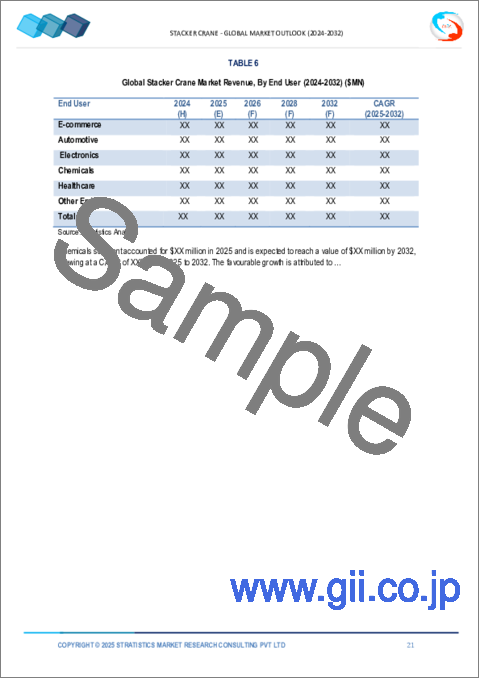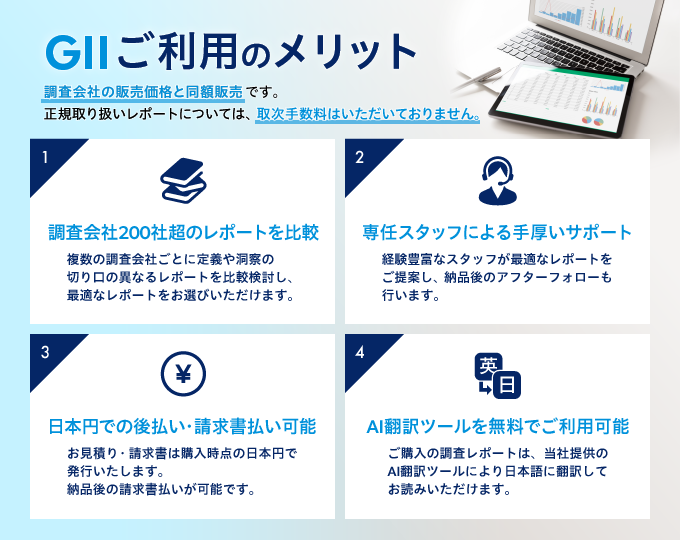|
|
市場調査レポート
商品コード
1530677
スタッカークレーンの2030年までの市場予測: タイプ別、制御タイプ別、積載量別、技術別、用途別、エンドユーザー別、地域別の世界分析Stacker Crane Market Forecasts to 2030 - Global Analysis By Type, Control Type, Load Capacity, Technology, Application, End User and By Geography |
||||||
カスタマイズ可能
|
|||||||
| スタッカークレーンの2030年までの市場予測: タイプ別、制御タイプ別、積載量別、技術別、用途別、エンドユーザー別、地域別の世界分析 |
|
出版日: 2024年08月01日
発行: Stratistics Market Research Consulting
ページ情報: 英文 200+ Pages
納期: 2~3営業日
|
全表示
- 概要
- 図表
- 目次
Stratistics MRCによると、スタッカークレーンの世界市場は2024年に10億8,000万米ドルを占め、予測期間中のCAGRは8.9%で成長し、2030年には16億8,000万米ドルに達すると予測されています。
スタッカークレーンは、倉庫や配送センターで製品の保管や取り出しに使用される自動マテリアルハンドリング装置です。垂直軸で動作するため、高い保管棚に効率的に商品を積み上げることができます。これらのシステムは、スペース利用を高め、保管されている商品への迅速なアクセスを提供することで在庫管理を改善し、多くの場合、合理化されたオペレーションのための倉庫管理システムと統合されています。
Port Technologyによると、2022年上半期に中国全土の港湾で取り扱われたTEUは1億4,230万個で、2021年比で3%の伸びを示しました。
自動倉庫ソリューションへの需要の高まり
企業がサプライチェーンの最適化と人件費の削減を求める中、スタッカークレーンは在庫管理のための信頼性が高くスペース効率の高い自動化システムを提供しています。この動向は、クレーンの性能やスマート倉庫への統合を向上させるIoTやロボット工学などの技術の進歩によってさらに加速しています。さらに、eコマースの台頭は、より迅速な注文処理を必要とし、消費者の期待の高まりに応えるためにスタッカークレーンのような自動化システムへの投資を促進しています。
限られた柔軟性
スタッカークレーンの柔軟性が限られているのは、特定の保管構成や製品タイプ向けに設計されているためで、さまざまな用途への適応性が制限される可能性があります。この特殊性は、多様な倉庫環境での使用を妨げ、在庫ニーズが変化する企業にとって課題となります。潜在的な顧客は、追加コストをかけずに進化する物流需要に適応できる機器を求めているため、このような消極的な姿勢は市場の成長を鈍らせる可能性があります。
eコマースの拡大
オンライン小売業者が在庫管理と注文処理の最適化に努める中、スタッカークレーンは商品の迅速な保管と取り出しのための信頼できる方法を提供します。この自動化により、人件費を削減し、人的ミスを最小限に抑え、処理時間を短縮することができます。さらに、倉庫の垂直保管スペースを最大化する必要性は、スタッカークレーンの能力と完全に一致するため、現代のeコマース・ロジスティクスに不可欠な要素となっています。したがって、eコマースの拡大はスタッカークレーン市場の成長を大きく後押ししています。
高い初期費用
スタッカークレーンの高い初期費用は、高度な自動化システムやロボット工学を含むその技術の複雑さから生じる。これらのシステムはしばしば、ラッキングシステム、制御ソフトウェア、安全対策などのインフラへの多額の投資を伴う。さらに、これらの投資の資本集約的な性質は、ROIのタイムラインを長引かせ、経済の不確実性の間に潜在的な買い手を思いとどまらせる可能性があります。このような出費は、スタッカークレーン技術の採用を中小企業に思いとどまらせ、市場浸透を制限する可能性があります。
COVID-19の影響
COVID-19の大流行はスタッカークレーン市場に大きな影響を与え、サプライチェーンの混乱と労働力不足を引き起こしました。産業界が操業上の課題に直面し、プロジェクトや投資の遅れにつながったため、需要は変動しました。しかし、自動化へのシフトとeコマースの成長により、効率的な倉庫管理とロジスティクスのためのスタッカークレーンへの関心が再び高まった。回復が進むにつれて、企業は生産性と安全性を高める技術への投資を開始し、将来の市場動向を形成しました。
予測期間中、自動化セグメントが最大になる見込み
自動化セグメントは有利な成長を遂げると推定されます。自動スタッカークレーンは、倉庫や配送センターで資材を効率的に保管・回収するために設計されたロボットシステムです。ラッキングシステム内で動作し、垂直移動を利用して物品(通常はパレット)を積み重ねたり積み下ろしたりします。これらのクレーンは、手作業を最小限に抑え、ミスを減らし、スペース利用を最適化することで生産性を向上させる。クレーンはしばしば倉庫管理システムと統合され、リアルタイムの在庫追跡と合理化されたオペレーションを実現し、より迅速な注文処理を可能にします。
予測期間中、eコマース分野のCAGRが最も高くなる見込み
eコマース分野は予測期間中に最も高いCAGRの成長が見込まれます。スタッカークレーンは、在庫を効率的に管理するためにeコマース倉庫で使用される自動保管・検索システムです。トラック上で動作し、高密度の棚ユニットに商品を取り出し、保管します。スペースを最適化し、手作業を減らすことで、スタッカークレーンは注文処理のスピードと精度を高めます。この技術は、製品への迅速なアクセスを可能にし、サプライチェーンを合理化し、ペースの速いeコマース環境における全体的な業務効率を向上させる。
最もシェアの大きい地域:
アジア太平洋地域のスタッカークレーン市場は、倉庫管理・物流分野における自動化の進展に牽引され、大きな成長を遂げています。効率的な在庫管理とスペースの最適化に対する需要の高まりが採用を後押ししています。eコマースや製造業を含む主要産業は、先進的なマテリアルハンドリングソリューションに投資しています。AIやIoT統合などの技術的進歩は、業務効率を高め、人件費を削減します。中国や日本などの国々が市場をリードしているが、新興国も産業活動の拡大により急速な導入が見られます。
CAGRが最も高い地域:
北米のスタッカークレーン市場は、倉庫や配送センターにおける自動化の進展に牽引され、著しい成長を遂げています。eコマース需要の高まりと効率的な在庫管理の必要性が、市場拡大をさらに後押ししています。同市場は、複数の有力企業が多様な産業用途に合わせたスタッカークレーン・ソリューションのラインナップを提供することで競争が激化しており、この地域全体で拡張性と柔軟性に優れた倉庫自動化ソリューションに対する需要が高まっていることを反映しています。
無料のカスタマイズ提供:
本レポートをご購読のお客様には、以下の無料カスタマイズオプションのいずれかをご利用いただけます:
- 企業プロファイル
- 追加市場プレイヤーの包括的プロファイリング(3社まで)
- 主要企業のSWOT分析(3社まで)
- 地域セグメンテーション
- 顧客の関心に応じた主要国の市場推計・予測・CAGR(注:フィージビリティチェックによる)
- 競合ベンチマーキング
- 製品ポートフォリオ、地理的プレゼンス、戦略的提携に基づく主要企業のベンチマーキング
目次
第1章 エグゼクティブサマリー
第2章 序文
- 概要
- ステークホルダー
- 調査範囲
- 調査手法
- データマイニング
- データ分析
- データ検証
- 調査アプローチ
- 調査情報源
- 1次調査情報源
- 2次調査情報源
- 前提条件
第3章 市場動向分析
- 促進要因
- 抑制要因
- 機会
- 脅威
- 技術分析
- 用途分析
- エンドユーザー分析
- 新興市場
- COVID-19の影響
第4章 ポーターのファイブフォース分析
- 供給企業の交渉力
- 買い手の交渉力
- 代替品の脅威
- 新規参入業者の脅威
- 競争企業間の敵対関係
第5章 世界のスタッカークレーン市場:タイプ別
- ユニットロードスタッカークレーン
- ミニロードスタッカークレーン
- 自動倉庫システム(ASRS)
- カスタムスタッカークレーン
- その他のタイプ
第6章 世界のスタッカークレーン市場:制御タイプ別
- プログラマブルロジックコントローラ(PLC)制御
- コンピュータ数値制御(CNC)制御
第7章 世界のスタッカークレーン市場:積載量別
- ライトデューティ
- ミディアムデューティ
- ヘビーデューティー
第8章 世界のスタッカークレーン市場:技術別
- 従来型
- 自動化
第9章 世界のスタッカークレーン市場:用途別
- 倉庫保管
- 製造業
- 配送センター
- その他の用途
第10章 世界のスタッカークレーン市場:エンドユーザー別
- eコマース
- 自動車
- エレクトロニクス
- 化学薬品
- ヘルスケア
- その他のエンドユーザー
第11章 世界のスタッカークレーン市場:地域別
- 北米
- 米国
- カナダ
- メキシコ
- 欧州
- ドイツ
- 英国
- イタリア
- フランス
- スペイン
- その他欧州
- アジア太平洋
- 日本
- 中国
- インド
- オーストラリア
- ニュージーランド
- 韓国
- その他アジア太平洋地域
- 南米
- アルゼンチン
- ブラジル
- チリ
- その他南米
- 中東・アフリカ
- サウジアラビア
- アラブ首長国連邦
- カタール
- 南アフリカ
- その他中東とアフリカ
第12章 主な発展
- 契約、パートナーシップ、コラボレーション、合弁事業
- 買収と合併
- 新製品発売
- 事業拡大
- その他の主要戦略
第13章 企業プロファイリング
- Toyota Industries Corporation
- Honeywell Intelligrated
- Crown Equipment Corporation
- Sick AG
- Bastian Solutions
- Hannover Re
- Swisslog Holding AG
- Vanderlande Industries B.V.
- Schaefer Systems International
- Kion Group AG
- Daifuku Corporation
- Mecalux S.A.
- Viastore Systems GmbH
- Westfalia Technologies Inc.
- Ferretto Group S.p.A.
- Jervis B. Webb Company
- Egemin Automation
- Stoecklin Logistics
List of Tables
- Table 1 Global Stacker Crane Market Outlook, By Region (2022-2030) ($MN)
- Table 2 Global Stacker Crane Market Outlook, By Type (2022-2030) ($MN)
- Table 3 Global Stacker Crane Market Outlook, By Unit Load Stacker Cranes (2022-2030) ($MN)
- Table 4 Global Stacker Crane Market Outlook, By Mini Load Stacker Cranes (2022-2030) ($MN)
- Table 5 Global Stacker Crane Market Outlook, By Auto Storage & Retrieval Systems (ASRS) (2022-2030) ($MN)
- Table 6 Global Stacker Crane Market Outlook, By Custom Stacker Cranes (2022-2030) ($MN)
- Table 7 Global Stacker Crane Market Outlook, By Other Types (2022-2030) ($MN)
- Table 8 Global Stacker Crane Market Outlook, By Control Type (2022-2030) ($MN)
- Table 9 Global Stacker Crane Market Outlook, By Programmable Logic Controller (PLC) Controlled (2022-2030) ($MN)
- Table 10 Global Stacker Crane Market Outlook, By Computer Numerical Control (CNC) Controlled (2022-2030) ($MN)
- Table 11 Global Stacker Crane Market Outlook, By Load Capacity (2022-2030) ($MN)
- Table 12 Global Stacker Crane Market Outlook, By Light-Duty (2022-2030) ($MN)
- Table 13 Global Stacker Crane Market Outlook, By Medium-Duty (2022-2030) ($MN)
- Table 14 Global Stacker Crane Market Outlook, By Heavy-Duty (2022-2030) ($MN)
- Table 15 Global Stacker Crane Market Outlook, By Technology (2022-2030) ($MN)
- Table 16 Global Stacker Crane Market Outlook, By Conventional (2022-2030) ($MN)
- Table 17 Global Stacker Crane Market Outlook, By Automated (2022-2030) ($MN)
- Table 18 Global Stacker Crane Market Outlook, By Application (2022-2030) ($MN)
- Table 19 Global Stacker Crane Market Outlook, By Warehousing (2022-2030) ($MN)
- Table 20 Global Stacker Crane Market Outlook, By Manufacturing (2022-2030) ($MN)
- Table 21 Global Stacker Crane Market Outlook, By Distribution Centers (2022-2030) ($MN)
- Table 22 Global Stacker Crane Market Outlook, By Other Applications (2022-2030) ($MN)
- Table 23 Global Stacker Crane Market Outlook, By End User (2022-2030) ($MN)
- Table 24 Global Stacker Crane Market Outlook, By E-commerce (2022-2030) ($MN)
- Table 25 Global Stacker Crane Market Outlook, By Automotive (2022-2030) ($MN)
- Table 26 Global Stacker Crane Market Outlook, By Electronics (2022-2030) ($MN)
- Table 27 Global Stacker Crane Market Outlook, By Chemicals (2022-2030) ($MN)
- Table 28 Global Stacker Crane Market Outlook, By Healthcare (2022-2030) ($MN)
- Table 29 Global Stacker Crane Market Outlook, By Other End Users (2022-2030) ($MN)
Note: Tables for North America, Europe, APAC, South America, and Middle East & Africa Regions are also represented in the same manner as above.
According to Stratistics MRC, the Global Stacker Crane Market is accounted for $1.08 billion in 2024 and is expected to reach $1.68 billion by 2030 growing at a CAGR of 8.9% during the forecast period. A stacker crane is an automated material handling device used in warehouses and distribution centers to store and retrieve products. It operates on a vertical axis, allowing it to stack items in high storage racks efficiently. These systems enhance space utilization and improve inventory management by providing rapid access to stored goods, often integrated with warehouse management systems for streamlined operations.
According to Port Technology, during the first half of 2022, ports across China handled a combined 142.3 million TEU, reflecting a 3% growth compared to 2021.
Market Dynamics:
Driver:
Growing demand for automated warehousing solutions
As businesses seek to optimize their supply chains and reduce labor costs, stacker cranes offer reliable and space-efficient automated systems for inventory management. This trend is further fuelled by advancements in technology, such as IoT and robotics, which improve crane performance and integration into smart warehouses. Additionally, the rise of e-commerce necessitates faster order fulfillment, driving investments in automated systems like stacker cranes to meet increasing consumer expectations.
Restraint:
Limited flexibility
Limited flexibility in stacker cranes arises from their design for specific storage configurations and product types, which can restrict their adaptability across various applications. This specialization can hinder their use in diverse warehouse settings, making it challenging for businesses with changing inventory needs. This reluctance can slow market growth, as potential customers seek equipment that can adapt to evolving logistics demands without incurring additional costs.
Opportunity:
Expansion of e-commerce
As online retailers strive to optimize inventory management and order fulfillment, stacker cranes provide a reliable method for rapid storage and retrieval of goods. This automation reduces labor costs, minimizes human error, and accelerates processing times, crucial for meeting consumer expectations for quick delivery. Additionally, the need for maximizing vertical storage space in warehouses aligns perfectly with the capabilities of stacker cranes, making them an essential component in modern e-commerce logistics. Therefore, the expansion of e-commerce significantly propels the growth of the stacker crane market.
Threat:
High upfront costs
High upfront costs for stacker cranes arise from the complexity of their technology, including advanced automation systems and robotics. These systems often involve significant investments in infrastructure, such as racking systems, control software, and safety measures. Moreover, the capital-intensive nature of these investments may prolong ROI timelines, dissuading potential buyers during economic uncertainties. Such expenses can deter smaller businesses from adopting stacker crane technology, limiting market penetration.
Covid-19 Impact
The covid-19 pandemic significantly impacted the stacker crane market, causing supply chain disruptions and labor shortages. Demand fluctuated as industries faced operational challenges, leading to delays in projects and investments. However, the shift towards automation and e-commerce growth drove renewed interest in stacker cranes for efficient warehousing and logistics. As recovery progressed, companies began investing in technology to enhance productivity and safety, shaping future market trends.
The automated segment is expected to be the largest during the forecast period
The automated segment is estimated to have a lucrative growth. An automated stacker crane is a robotic system designed for efficient storage and retrieval of materials in warehouses and distribution centers. It operates within a racking system, utilizing vertical movement to stack or unstack items, typically pallets. These cranes enhance productivity by minimizing manual labor, reducing errors, and optimizing space utilization. They are often integrated with warehouse management systems for real-time inventory tracking and streamlined operations, ensuring faster order fulfillment.
The e-commerce segment is expected to have the highest CAGR during the forecast period
The e-commerce segment is anticipated to witness the highest CAGR growth during the forecast period. A stacker crane is an automated storage and retrieval system used in e-commerce warehouses to efficiently manage inventory. It operates on tracks, retrieving and storing goods in high-density shelving units. By optimizing space and reducing manual labor, stacker cranes enhance order fulfillment speed and accuracy. This technology allows for quick access to products, streamlining the supply chain and improving overall operational efficiency in the fast-paced e-commerce environment.
Region with largest share:
The stacker crane market in the Asia-Pacific region is experiencing significant growth, driven by increasing automation in warehousing and logistics sectors. The rising demand for efficient inventory management and space optimization is boosting adoption. Key industries, including e-commerce and manufacturing, are investing in advanced material handling solutions. Technological advancements, such as AI and IoT integration, enhance operational efficiency and reduce labor costs. Countries like China and Japan are leading the market, while emerging economies are also witnessing rapid adoption due to expanding industrial activities.
Region with highest CAGR:
The stacker crane market in North America is witnessing significant growth, driven by increasing automation in warehouses and distribution centers. The rising demand for e-commerce and the need for efficient inventory management are further fueling market expansion. The market is competitive with several prominent players offering a range of stacker crane solutions tailored to diverse industrial applications, reflecting a strong demand for scalable and flexible warehouse automation solutions across the region.
Key players in the market
Some of the key players profiled in the Stacker Crane Market include Toyota Industries Corporation, Honeywell Intelligrated, Crown Equipment Corporation, Sick AG, Bastian Solutions, Hannover Re, Swisslog Holding AG, Vanderlande Industries B.V., Schaefer Systems International, Kion Group AG, Daifuku Corporation, Mecalux S.A., Viastore Systems GmbH, Westfalia Technologies Inc., Ferretto Group S.p.A., Jervis B. Webb Company, Egemin Automation and Stoecklin Logistics.
Key Developments:
In November 2021, Honeywell announced its latest solution in intelligent automated handling designed to help warehouses, distribution centers and manufacturing sites receive, process and fill orders faster and more accurately while potentially reducing storage footprint.
In October 2020, Stoecklin Logistics introduced a line of dynamic MASTer(TM) Stacker Cranes that feature high acceleration and moving speeds, improved energy efficiency. The new cranes also have simpler and faster wheels and hoists, greater standardization across different cranes and load carrying capacities, shorter assembly and manufacturing times, lighter construction and improved accessibility to components for maintenance.
Types Covered:
- Unit Load Stacker Cranes
- Mini Load Stacker Cranes
- Auto Storage & Retrieval Systems (ASRS)
- Custom Stacker Cranes
- Other Types
Control Types Covered:
- Programmable Logic Controller (PLC) Controlled
- Computer Numerical Control (CNC) Controlled
Load Capacities Covered:
- Light-Duty
- Medium-Duty
- Heavy-Duty
Technologies Covered:
- Conventional
- Automated
Applications Covered:
- Warehousing
- Manufacturing
- Distribution Centers
- Other Applications
End Users Covered:
- E-commerce
- Automotive
- Electronics
- Chemicals
- Healthcare
- Other End Users
Regions Covered:
- North America
- US
- Canada
- Mexico
- Europe
- Germany
- UK
- Italy
- France
- Spain
- Rest of Europe
- Asia Pacific
- Japan
- China
- India
- Australia
- New Zealand
- South Korea
- Rest of Asia Pacific
- South America
- Argentina
- Brazil
- Chile
- Rest of South America
- Middle East & Africa
- Saudi Arabia
- UAE
- Qatar
- South Africa
- Rest of Middle East & Africa
What our report offers:
- Market share assessments for the regional and country-level segments
- Strategic recommendations for the new entrants
- Covers Market data for the years 2022, 2023, 2024, 2026, and 2030
- Market Trends (Drivers, Constraints, Opportunities, Threats, Challenges, Investment Opportunities, and recommendations)
- Strategic recommendations in key business segments based on the market estimations
- Competitive landscaping mapping the key common trends
- Company profiling with detailed strategies, financials, and recent developments
- Supply chain trends mapping the latest technological advancements
Free Customization Offerings:
All the customers of this report will be entitled to receive one of the following free customization options:
- Company Profiling
- Comprehensive profiling of additional market players (up to 3)
- SWOT Analysis of key players (up to 3)
- Regional Segmentation
- Market estimations, Forecasts and CAGR of any prominent country as per the client's interest (Note: Depends on feasibility check)
- Competitive Benchmarking
- Benchmarking of key players based on product portfolio, geographical presence, and strategic alliances
Table of Contents
1 Executive Summary
2 Preface
- 2.1 Abstract
- 2.2 Stake Holders
- 2.3 Research Scope
- 2.4 Research Methodology
- 2.4.1 Data Mining
- 2.4.2 Data Analysis
- 2.4.3 Data Validation
- 2.4.4 Research Approach
- 2.5 Research Sources
- 2.5.1 Primary Research Sources
- 2.5.2 Secondary Research Sources
- 2.5.3 Assumptions
3 Market Trend Analysis
- 3.1 Introduction
- 3.2 Drivers
- 3.3 Restraints
- 3.4 Opportunities
- 3.5 Threats
- 3.6 Technology Analysis
- 3.7 Application Analysis
- 3.8 End User Analysis
- 3.9 Emerging Markets
- 3.10 Impact of Covid-19
4 Porters Five Force Analysis
- 4.1 Bargaining power of suppliers
- 4.2 Bargaining power of buyers
- 4.3 Threat of substitutes
- 4.4 Threat of new entrants
- 4.5 Competitive rivalry
5 Global Stacker Crane Market, By Type
- 5.1 Introduction
- 5.2 Unit Load Stacker Cranes
- 5.3 Mini Load Stacker Cranes
- 5.4 Auto Storage & Retrieval Systems (ASRS)
- 5.5 Custom Stacker Cranes
- 5.6 Other Types
6 Global Stacker Crane Market, By Control Type
- 6.1 Introduction
- 6.2 Programmable Logic Controller (PLC) Controlled
- 6.3 Computer Numerical Control (CNC) Controlled
7 Global Stacker Crane Market, By Load Capacity
- 7.1 Introduction
- 7.2 Light-Duty
- 7.3 Medium-Duty
- 7.4 Heavy-Duty
8 Global Stacker Crane Market, By Technology
- 8.1 Introduction
- 8.2 Conventional
- 8.3 Automated
9 Global Stacker Crane Market, By Application
- 9.1 Introduction
- 9.2 Warehousing
- 9.3 Manufacturing
- 9.4 Distribution Centers
- 9.5 Other Applications
10 Global Stacker Crane Market, By End User
- 10.1 Introduction
- 10.2 E-commerce
- 10.3 Automotive
- 10.4 Electronics
- 10.5 Chemicals
- 10.6 Healthcare
- 10.7 Other End Users
11 Global Stacker Crane Market, By Geography
- 11.1 Introduction
- 11.2 North America
- 11.2.1 US
- 11.2.2 Canada
- 11.2.3 Mexico
- 11.3 Europe
- 11.3.1 Germany
- 11.3.2 UK
- 11.3.3 Italy
- 11.3.4 France
- 11.3.5 Spain
- 11.3.6 Rest of Europe
- 11.4 Asia Pacific
- 11.4.1 Japan
- 11.4.2 China
- 11.4.3 India
- 11.4.4 Australia
- 11.4.5 New Zealand
- 11.4.6 South Korea
- 11.4.7 Rest of Asia Pacific
- 11.5 South America
- 11.5.1 Argentina
- 11.5.2 Brazil
- 11.5.3 Chile
- 11.5.4 Rest of South America
- 11.6 Middle East & Africa
- 11.6.1 Saudi Arabia
- 11.6.2 UAE
- 11.6.3 Qatar
- 11.6.4 South Africa
- 11.6.5 Rest of Middle East & Africa
12 Key Developments
- 12.1 Agreements, Partnerships, Collaborations and Joint Ventures
- 12.2 Acquisitions & Mergers
- 12.3 New Product Launch
- 12.4 Expansions
- 12.5 Other Key Strategies
13 Company Profiling
- 13.1 Toyota Industries Corporation
- 13.2 Honeywell Intelligrated
- 13.3 Crown Equipment Corporation
- 13.4 Sick AG
- 13.5 Bastian Solutions
- 13.6 Hannover Re
- 13.7 Swisslog Holding AG
- 13.8 Vanderlande Industries B.V.
- 13.9 Schaefer Systems International
- 13.10 Kion Group AG
- 13.11 Daifuku Corporation
- 13.12 Mecalux S.A.
- 13.13 Viastore Systems GmbH
- 13.14 Westfalia Technologies Inc.
- 13.15 Ferretto Group S.p.A.
- 13.16 Jervis B. Webb Company
- 13.17 Egemin Automation
- 13.18 Stoecklin Logistics





